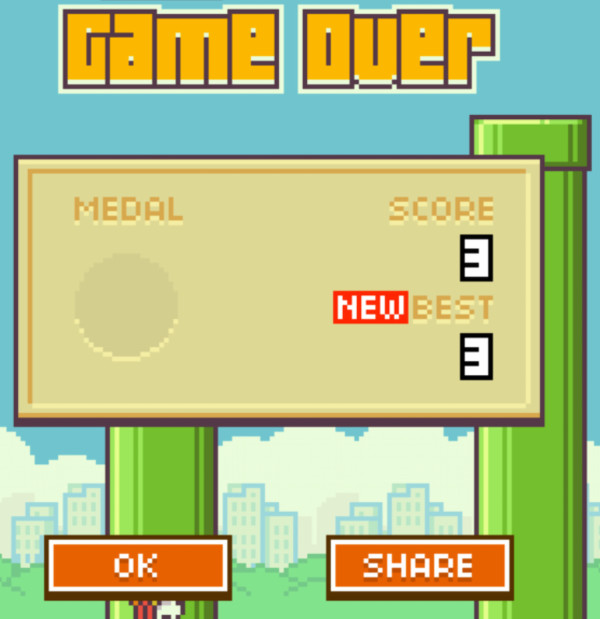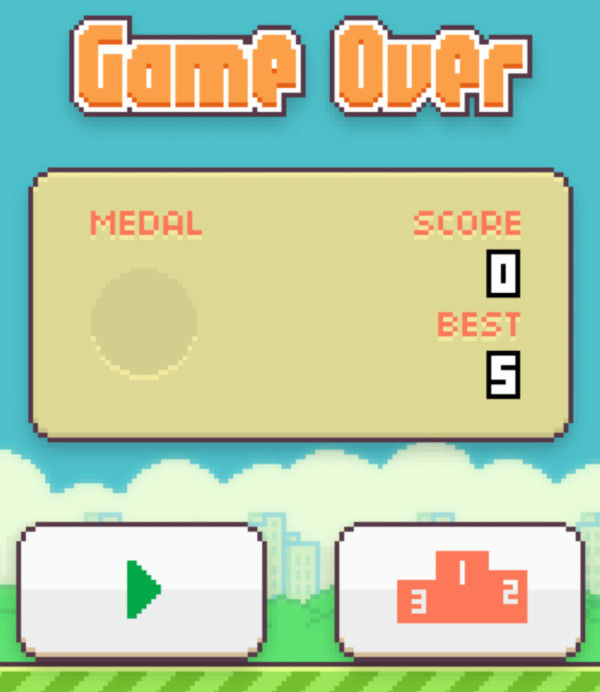The Viral Rise & Fall Of Flappy Bird
Flappy Bird, the maddening free app that seemed to appeared out of nowhere two weeks ago, is a great lesson on how a simple “Share” button may help an app go viral or at least continue to generate buzz. And, on the eve of Flappy Bird going away forever, it also demonstrates how novelty can […]
Flappy Bird, the maddening free app that seemed to appeared out of nowhere two weeks ago, is a great lesson on how a simple “Share” button may help an app go viral or at least continue to generate buzz. And, on the eve of Flappy Bird going away forever, it also demonstrates how novelty can also quickly wear off.
The Unexpected Number One
For those unfamiliar, Flappy Bird requires those playing the iOS and Android game to tap, tap, tap to keep their bird flying through a series of obstacles. Tough obstacles.
The game recently shot to the top of the iTunes and Google Play charts, where it still resides as the top free app:


A Focus On Sharing
One of the key things about the game is that, until recently, it made sharing very simple. After every crash (and you crash a lot) you would get this screen:

Two buttons: “OK,” to open a new screen asking if you wanted to play again, and “Share,” to spread the news about your progress on Twitter, Facebook or through SMS.
For Twitter, Flappy Bird would automatically share a message like this from the iOS version:
OMG! I scored 0 pts in #flapflap!!! -> http://itunes.apple.com/app/id642099621
Rise & Fall Of #Flapflap On Twitter
Using the #flapflap hashtag, it’s pretty easy to see just how effective that button was to spread the viral news of the game. Consider this chart from Topsy (which ends on Feb. 7, not Feb 8, even though that’s the time range stated in the text):

Topsy lets you track the popularity of words on Twitter. You can see how the hashtag started picking up around January 20 then really started climbing high from January 25 onward. As more people discovered the game, the tweets with the hashtag — many of which were generated from the app’s own share button — kept going, spreading the news and a link to where it could be downloaded.
The big drop on Feb. 7 corresponds to when the iOS version of the app was updated, to drop the share button:

The slight dip on February 3 might be the result of the play button being dropped from the Android version of the app, which was updated on January 30. Losing the button might have lead to a drop as people started updating on Android. However, the Android version might not have ever had a share button (I didn’t use it, but doing some checks on sharing, I don’t think it did)
The share message might have been different earlier this month (I only started playing Flappy Bird this week, so I don’t know). If so, #flapflap might not have been used but the app URL might have been made shareable. And if so, that might help explain this:

That chart shows how often links to the iOS version of the app were shared on Twitter, with the #flapflap tweets also listed below. You can see that the links far eclipse the hashtag usage, and the viral growth is less pronounced. Perhaps there’s some other reason why the links don’t show the viral spike that the hashtag does.
One thing against the sharing button helping with the viral success is this chart from app tracking service App Annie (click to enlarge):
That chart shows that as of January 1, Flappy Bird was ranked 313 in Apple’s app store. It started climbing a bit, leveled out, then climbed again to break the top 100 on January 8. By January 9, it was in the top 30. January 10 saw it hit the top 10. It took the number one spot on January 17.
That puts Flappy Bird as a viral success before the hashtag sharing started on Twitter. But as I said, another sharing message might have been used that I can’t track. And maybe, in the end, the sharing button just added to the buzz after the success was already happening in the app stores for other reasons.
Developer To Ground Flappy Bird
I’d planned to explore all this much more in depth this week, trying to dig into how sharing on Facebook might have also helped. But that no longer matters.
Flappy Bird’s viral success is being stopped by its creator Dong Nguyen, who tweeted today that he “cannot take this anymore” and will be pulling the game shortly:
I am sorry ‘Flappy Bird’ users, 22 hours from now, I will take ‘Flappy Bird’ down. I cannot take this anymore.
— Dong Nguyen (@dongatory) February 8, 2014
Gizmodo, The Verge and TechCrunch all have more on further tweets from him, where he states he’s not doing it for any legal reasons but rather because people might be “overusing” his game.
TechCrunch also has a nice interview from earlier this week with Nguyen, where he’s not sure how the game — which has been out since May 2013 — became so popular suddenly.
Again, maybe having the share button didn’t make that much of a difference to starting up Flappy Bird’s rise. But once it was climbed, having that button constantly appear rather than a “Play Again” button sure feels like it helped contribute to the success.
Have your own theories on what contributed to Flappy Bird’s success? Please share them in the comments, below.
Contributing authors are invited to create content for MarTech and are chosen for their expertise and contribution to the search community. Our contributors work under the oversight of the editorial staff and contributions are checked for quality and relevance to our readers. MarTech is owned by Semrush. Contributor was not asked to make any direct or indirect mentions of Semrush. The opinions they express are their own.
Related stories
New on MarTech
